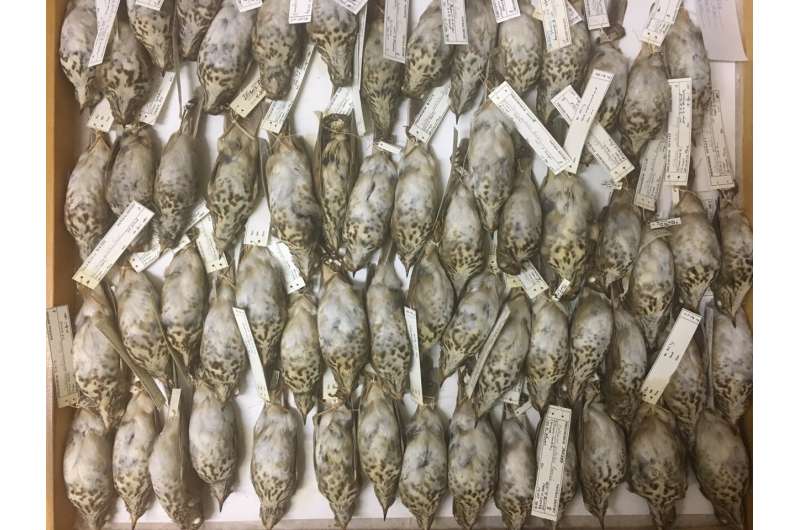A final present from birds killed in window collisions: poop that reveals their microbiomes

Every year, millions of birds crash into windows in cities along their migratory path. For decades, scientists and volunteers have risen at dawn in spring and fall to collect the fallen birds, rehabilitating the injured and documenting the dead. The bodies of the birds killed in these collisions are a treasure trove of scientific information, especially when compared year after year. A new study in the journal Molecular Ecology makes use of these specimens to help understand the relationship between birds and the microbes living in their guts—which appears to be wildly different from mammals and their microbiomes. The scientists’ work involved DNA sequencing, and a whole lot of bird poop.
“In humans, the gut microbiome—the collection of bacteria, fungi, and other microbes living in our digestive tracts—is incredibly important to our general health and can even influence our behavior. But scientists are still trying to figure out how significant a role the microbiome has with birds,” says Heather Skeen, a research associate at the Field Museum who completed her Ph.D. through the Field and the University of Chicago.
Scientists have found that in our fellow mammals, different species tend to have their own signature array of gut microbes that help them digest food and fight off disease. DNA studies have even shown that these relationships can go back millions of years, with different mammals co-evolving with their microbiomes in a symbiotic relationship that benefits both the mammal and its microbes. But researchers like Skeen have been finding that birds’ microbiomes likely play by a different set of rules.
“Bird gut microbiomes don’t seem to be as closely tied to host species, so we want to know what does influence them,” says Skeen. “The goal of this study was to see if bird microbiomes are consistent, or if they change over short time periods.”
While dozens of species arrive at the Field Museum after crashing into Chicago’s buildings, Skeen focused on four common species of songbirds called thrushes, in order to ensure a large sample size. To study the thrushes’ gut microbiomes, Skeen went right to the source. “You make a small incision into the abdomen to reach the intestines, and then you squeeze out the contents,” says Skeen. Overall, she took samples from 747 birds over the course of 3 years, supplementing the Chicago birds with additional samples taken from thrushes in their summer breeding ground in Michigan, Minnesota, and Manitoba.
After transferring the bird poop from their intestines to specialized filter paper cards that preserve DNA, the researchers sent the genetic material off for bacteria classification.

“Analyzing the bacterial DNA present in the poop allowed us to determine exactly what kinds of bacteria were present,” says Skeen. “It turns out, there were about 27,000 different types of bacteria present.”
Skeen and her colleagues looked for trends in the bacteria present across the 747 birds in the sample. They found that, unlike in mammals, the different bird species didn’t seem to have their own unique set of microbes. Instead, the clearest link between the birds and the bacteria in their microbiomes was time: season to season, year to year, the birds’ gut microbes changed.
“Across the years, there were fairly significant differences in the composition of the bacteria, which was surprising,” says Skeen.
These findings point to birds’ microbiomes likely having more to do with the environment around them than the inborn, consistent relationship seen in most mammals.
“Heather’s research is blowing people’s minds about what a microbiome is or isn’t,” says Shannon Hackett, associate curator of birds at the Field and a co-author of the paper. “How do birds have functioning immune systems, if their microbiomes change so much in just a few months? It’s hard to weave that into a consistent theory about how they digest food, how they reject parasites, all the things we think of the microbiome doing in humans. How does that work?”
Hackett also says that the study helps illustrate the value of museum collections. Study co-author and Field collections manager emeritus Dave Willard began picking up birds killed by nearby Chicago buildings forty years ago, she notes.
“At the time, people were like, ‘What the hell are you doing?’ But the fact that he’s been doing this for forty years means we have a unique opportunity to study birds across fairly short periods of time. We have more than 100,000 window-killed birds at this point, it’s an incredibly rich resource,” says Hackett. “And as technology evolves and new scientists like Heather come up, we broaden what we’re able to do with these resources.”
More information:
Intestinal microbiota of Nearctic-Neotropical migratory birds vary more over seasons and years than between host species, Molecular Ecology (2023).
Citation:
A final present from birds killed in window collisions: poop that reveals their microbiomes (2023, March 28)
retrieved 28 March 2023
from https://phys.org/news/2023-03-birds-window-collisions-poop-reveals.html
This document is subject to copyright. Apart from any fair dealing for the purpose of private study or research, no
part may be reproduced without the written permission. The content is provided for information purposes only.
For all the latest Science News Click Here
For the latest news and updates, follow us on Google News.

